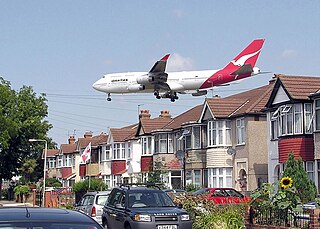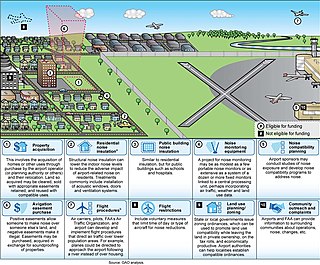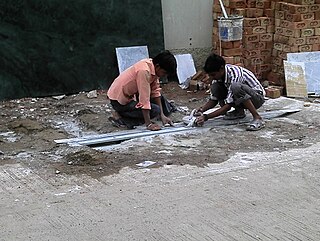Related Research Articles

In atmospheric sounding and noise pollution, ambient noise level is the background sound pressure level at a given location, normally specified as a reference level to study a new intrusive sound source.

A weighting filter is used to emphasize or suppress some aspects of a phenomenon compared to others, for measurement or other purposes.

Noise is unwanted sound considered unpleasant, loud, or disruptive to hearing. From a physics standpoint, there is no distinction between noise and desired sound, as both are vibrations through a medium, such as air or water. The difference arises when the brain receives and perceives a sound.
A noise weighting is a specific amplitude-vs.-frequency characteristic that is designed to allow subjectively valid measurement of noise. It emphasises the parts of the spectrum that are most important.

Noise pollution, or sound pollution, is the propagation of noise or sound with ranging impacts on the activity of human or animal life, most of which are harmful to a degree. The source of outdoor noise worldwide is mainly caused by machines, transport and propagation systems. Poor urban planning may give rise to noise disintegration or pollution, side-by-side industrial and residential buildings can result in noise pollution in the residential areas. Some of the main sources of noise in residential areas include loud music, transportation, lawn care maintenance, construction, electrical generators, wind turbines, explosions and people.

Environmental noise is an accumulation of noise pollution that occurs outside. This noise can be caused by transport, industrial, and recreational activities.

In acoustics, loudness is the subjective perception of sound pressure. More formally, it is defined as the "attribute of auditory sensation in terms of which sounds can be ordered on a scale extending from quiet to loud". The relation of physical attributes of sound to perceived loudness consists of physical, physiological and psychological components. The study of apparent loudness is included in the topic of psychoacoustics and employs methods of psychophysics.
Occupational noise is the amount of acoustic energy received by an employee's auditory system when they are working in the industry. Occupational noise, or industrial noise, is often a term used in occupational safety and health, as sustained exposure can cause permanent hearing damage. Occupational noise is considered an occupational hazard traditionally linked to loud industries such as ship-building, mining, railroad work, welding, and construction, but can be present in any workplace where hazardous noise is present.

Occupational hygiene is the anticipation, recognition, evaluation, control, and confirmation (ARECC) of protection from risks associated with exposures to hazards in, or arising from, the workplace that may result in injury, illness, impairment, or affect the well-being of workers and members of the community. These hazards or stressors are typically divided into the categories biological, chemical, physical, ergonomic and psychosocial. The risk of a health effect from a given stressor is a function of the hazard multiplied by the exposure to the individual or group. For chemicals, the hazard can be understood by the dose response profile most often based on toxicological studies or models. Occupational hygienists work closely with toxicologists for understanding chemical hazards, physicists for physical hazards, and physicians and microbiologists for biological hazards. Environmental and occupational hygienists are considered experts in exposure science and exposure risk management. Depending on an individual's type of job, a hygienist will apply their exposure science expertise for the protection of workers, consumers and/or communities.
A weighting curve is a graph of a set of factors, that are used to 'weight' measured values of a variable according to their importance in relation to some outcome. An important example is frequency weighting in sound level measurement where a specific set of weighting curves known as A-, B-, C- and D-weighting as defined in IEC 61672 are used. Unweighted measurements of sound pressure do not correspond to perceived loudness because the human ear is less sensitive at low and high frequencies, with the effect more pronounced at lower sound levels. The four curves are applied to the measured sound level, for example by the use of a weighting filter in a sound level meter, to arrive at readings of loudness in phons or in decibels (dB) above the threshold of hearing.

ITU-R 468 is a standard relating to noise measurement, widely used when measuring noise in audio systems. The standard, now referred to as ITU-R BS.468-4, defines a weighting filter curve, together with a quasi-peak rectifier having special characteristics as defined by specified tone-burst tests. It is currently maintained by the International Telecommunication Union who took it over from the CCIR.

The process of weighting involves emphasizing the contribution of particular aspects of a phenomenon over others to an outcome or result; thereby highlighting those aspects in comparison to others in the analysis. That is, rather than each variable in the data set contributing equally to the final result, some of the data is adjusted to make a greater contribution than others. This is analogous to the practice of adding (extra) weight to one side of a pair of scales in order to favour either the buyer or seller.

Noise control or noise mitigation is a set of strategies to reduce noise pollution or to reduce the impact of that noise, whether outdoors or indoors.

A sound level meter is used for acoustic measurements. It is commonly a hand-held instrument with a microphone. The best type of microphone for sound level meters is the condenser microphone, which combines precision with stability and reliability. The diaphragm of the microphone responds to changes in air pressure caused by sound waves. That is why the instrument is sometimes referred to as a sound pressure level meter (SPL). This movement of the diaphragm, i.e. the sound pressure, is converted into an electrical signal. While describing sound in terms of sound pressure, a logarithmic conversion is usually applied and the sound pressure level is stated instead, in decibels (dB), with 0 dB SPL equal to 20 micropascals.
Noise regulation includes statutes or guidelines relating to sound transmission established by national, state or provincial and municipal levels of government. After the watershed passage of the United States Noise Control Act of 1972, other local and state governments passed further regulations.

A-weighting is the most commonly used of a family of curves defined in the International standard IEC 61672:2003 and various national standards relating to the measurement of sound pressure level. A-weighting is applied to instrument-measured sound levels in an effort to account for the relative loudness perceived by the human ear, as the ear is less sensitive to low audio frequencies. It is employed by arithmetically adding a table of values, listed by octave or third-octave bands, to the measured sound pressure levels in dB. The resulting octave band measurements are usually added to provide a single A-weighted value describing the sound; the units are written as dB(A). Other weighting sets of values – B, C, D and now Z – are discussed below.

Hearing conservation programs are designed to prevent hearing loss due to noise. Hearing conservation programs require knowledge about risk factors such as noise and ototoxicity, hearing, hearing loss, protective measures to prevent hearing loss at home, in school, at work, in the military and, and at social/recreational events, and legislative requirements. Regarding occupational exposures to noise, a hearing conservation program is required by the Occupational Safety and Health Administration (OSHA) "whenever employee noise exposures equal or exceed an 8-hour time-weighted average sound level (TWA) of 85 decibels (dB) measured on the A scale or, equivalently, a dose of fifty percent." This 8-hour time-weighted average is known as an exposure action value. While the Mine Safety and Health Administration (MSHA) also requires a hearing conservation program, MSHA does not require a written hearing conservation program. MSHA's hearing conservation program requirement can be found in 30 CFR § 62.150, and is very similar to the OSHA hearing conservation program requirements. Therefore, only the OSHA standard 29 CFR 1910.95 will be discussed in detail.

A noise dosimeter or noise dosemeter is a specialized sound level meter intended specifically to measure the noise exposure of a person integrated over a period of time; usually to comply with Health and Safety regulations such as the Occupational Safety and Health (OSHA) 29 CFR 1910.95 Occupational Noise Exposure Standard or EU Directive 2003/10/EC.

Occupational hearing loss (OHL) is hearing loss that occurs as a result of occupational hazards, such as excessive noise and ototoxic chemicals. Noise is a common workplace hazard, and recognized as the risk factor for noise-induced hearing loss and tinnitus but it is not the only risk factor that can result in a work-related hearing loss. Also, noise-induced hearing loss can result from exposures that are not restricted to the occupational setting.

Safe listening is a framework for health promotion actions to ensure that sound-related recreational activities do not pose a risk to hearing.
References
- ↑ Audio, NTi. "Unattended Noise Monitoring" (PDF). www.nti-audio.com.
- ↑ Goines, Lisa; Hagler, Louis (March 2007). "Noise Pollution: A Modern Plague". Southern Medical Journal. 100 (3): 287–294. CiteSeerX 10.1.1.504.8717 . doi:10.1097/smj.0b013e3180318be5. ISSN 0038-4348. PMID 17396733. S2CID 23675085.
- ↑ "CAOHC Noise Measurement Course". www.caohc.org. Retrieved 2020-11-21.
- ↑ "Safety and Health Topics | Occupational Noise Exposure | Occupational Safety and Health Administration". www.osha.gov. Retrieved 2020-10-10.
- ↑ "Causes". www.ata.org. 2015-03-02. Retrieved 2020-10-10.
- ↑ Halperin, Demian (2014-12-01). "Environmental noise and sleep disturbances: A threat to health?". Sleep Science. 7 (4): 209–212. doi: 10.1016/j.slsci.2014.11.003 . ISSN 1984-0063. PMC 4608916 . PMID 26483931. S2CID 16121980.
- ↑ Chang, Ta-Yuan; Hwang, Bing-Fang; Liu, Chiu-Shong; Chen, Ren-Yin; Wang, Ven-Shing; Bao, Bo-Ying; Lai, Jim-Shoung (2013-04-15). "Occupational Noise Exposure and Incident Hypertension in Men: A Prospective Cohort Study". American Journal of Epidemiology. 177 (8): 818–825. doi: 10.1093/aje/kws300 . ISSN 0002-9262. PMID 23470795.
- ↑ "Open Office Noise Increases Stress". WebMD. Retrieved 2020-11-21.
- ↑ "Open Office Noise Increases Stress". WebMD. Retrieved 2020-11-21.
- ↑ Hansell, Anna L.; Blangiardo, Marta; Fortunato, Lea; Floud, Sarah; Hoogh, Kees de; Fecht, Daniela; Ghosh, Rebecca E.; Laszlo, Helga E.; Pearson, Clare; Beale, Linda; Beevers, Sean (2013-10-08). "Aircraft noise and cardiovascular disease near Heathrow airport in London: small area study". BMJ. 347: f5432. doi: 10.1136/bmj.f5432 . ISSN 1756-1833. PMID 24103537. S2CID 2991257.
- ↑ Hammer Monica S.; Swinburn Tracy K.; Neitzel Richard L. (2014-02-01). "Environmental Noise Pollution in the United States: Developing an Effective Public Health Response". Environmental Health Perspectives. 122 (2): 115–119. doi:10.1289/ehp.1307272. PMC 3915267 . PMID 24311120.
- ↑ "Review of noise impacts on marine mammals yields new policy recommendations". phys.org. Retrieved 2020-11-22.
- ↑ Salvi, Richard; Boettcher, Flint A. (2008), Conn, P. Michael (ed.), "Animal Models of Noise-Induced Hearing Loss", Sourcebook of Models for Biomedical Research, Totowa, NJ: Humana Press, pp. 289–301, doi:10.1007/978-1-59745-285-4_32, ISBN 978-1-59745-285-4 , retrieved 2020-10-10
- ↑ Diaz, Rodney C. (2014). "Noise-induced hearing loss: perspectives". Current Opinion in Otolaryngology & Head and Neck Surgery. 22 (5): 373. doi:10.1097/MOO.0000000000000084. ISSN 1531-6998. PMID 25101939.
- ↑ Barrier, Hatko (2020-04-20). "How much does noise barrier cost?". Hatko Sound Barrier. Retrieved 2020-11-22.
- ↑ "NPC Resources: Noise Increases with Vehicle Speed". nonoise.org. Retrieved 2020-11-22.
- ↑ atlanticei (2019-03-20). "Reducing Excessive Noise Using Engineering Methods | Atlantic Environmental". Atlantic Environmental Incorporated. Retrieved 2020-11-21.
- ↑ "Leading the way in aircraft noise reduction | Engineering | University of Southampton". www.southampton.ac.uk. Retrieved 2020-11-21.
- ↑ Potter, Sean (2018-06-25). "NASA Technologies Significantly Reduce Aircraft Noise". NASA. Retrieved 2020-11-21.
- ↑ "Reducing Aviation Noise, Advancing the Aviation Enterprise | Volpe National Transportation Systems Center". www.volpe.dot.gov. Retrieved 2020-11-21.
- ↑ "How to Control Aircraft Noise? | Noise Pollution". Essays, Research Papers and Articles on Environmental Pollution. 2018-03-12. Retrieved 2020-11-21.
- ↑ "Controls for Noise Exposure | NIOSH | CDC". www.cdc.gov. 2020-06-22. Retrieved 2020-11-22.
- ↑ "How is Sound Measured?". It's a Noisy Planet. Protect Their Hearing. 28 January 2019. Retrieved 2020-11-22.
- ↑ Woodford, Chris (2009-01-28). "How decibel sound level meters work". Explain that Stuff. Retrieved 2020-11-22.
- ↑ "Sound-level meter | instrument". Encyclopedia Britannica. Retrieved 2020-11-22.
- ↑ Selwyn, Bob (September 1, 2010). "The Use of Noise Dosimeters in the Workplace -". Occupational Health & Safety. Retrieved 2020-11-22.